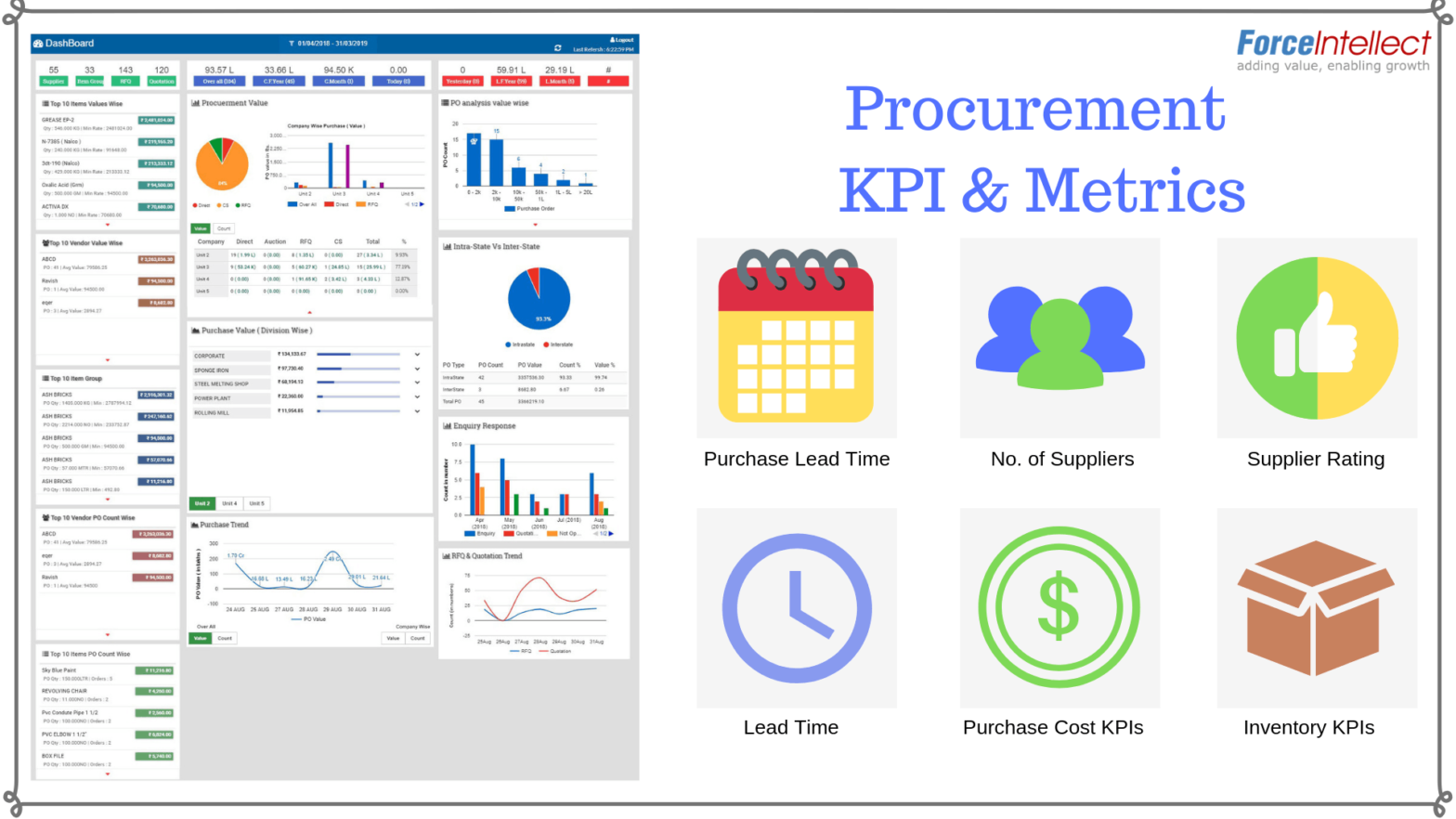Procurement KPI Metrics
Procurement is a vital business function and impacts the performance of an organization. It may affect product quality, costing, timely delivery, and customer satisfaction. So it is important for organizations to monitor and improve, performance and health of procurement. Procurement KPI metrics help organizations to track and report performance and effectiveness of procurement in meeting business objectives.
If you can measure it, you can improve it !
Measure Procurement Performance to achieve significant improvement in Procurement Performance. Here is a detailed list of Procurement Performance Metrics and Procurement KPI, which may help you to keep a close eye on the procurement function and improve the performance of procurement.
Procurement KPIs You Must Always Measure are:
Purchase Order Cycle Time
 It is a key KPI in measuring the performance of procurement activity. Purchase order cycle time is time between receipt of purchase requisition to releasing a purchase order to the vendors. This KPI indicates the preparedness of the procurement team. It reflects how efficiently the procurement team is able to execute intermediate tasks such as sending RFQs, receiving and comparing quotes, approvals, etc. Shorter purchase order cycle time confirms an efficient procurement strategy.
It is a key KPI in measuring the performance of procurement activity. Purchase order cycle time is time between receipt of purchase requisition to releasing a purchase order to the vendors. This KPI indicates the preparedness of the procurement team. It reflects how efficiently the procurement team is able to execute intermediate tasks such as sending RFQs, receiving and comparing quotes, approvals, etc. Shorter purchase order cycle time confirms an efficient procurement strategy.
No of Suppliers
Depending on very few suppliers can be a risk for procurement. This should be avoided. On the other hand, having too many suppliers can also reduce the chances of competition among supplier. Organizations should maintain healthy numbers of suppliers for all items category. Further, organizations may have a specific contract with these suppliers regarding defined terms, price and period of contract.
Supplier Ratings
 This KPI evaluates the performance of suppliers on various parameters. Few key parameters can be response rate, on-time delivery of material, quality of material, invoice accuracy. Supplier ratings help in identifying the strength of the current supplier base. It helps in identifying strong and weak suppliers. Companies can use supplier ratings to identify, reward and retain well-performing suppliers and to identify, take corrective action regarding weak suppliers.
This KPI evaluates the performance of suppliers on various parameters. Few key parameters can be response rate, on-time delivery of material, quality of material, invoice accuracy. Supplier ratings help in identifying the strength of the current supplier base. It helps in identifying strong and weak suppliers. Companies can use supplier ratings to identify, reward and retain well-performing suppliers and to identify, take corrective action regarding weak suppliers.
Lead Time
 Lead time is the time interval between releasing a purchase requisition to receiving the materials in the warehouse. Lead time depends on various other factors such as purchase order cycle time, order handling time, manufacturing lead time, delivery lead time, etc. Lead time has a direct impact on inventory level, a higher lead time means a higher inventory level. An effective procurement strategy can lower the lead time and reduce the inventory level.
Lead time is the time interval between releasing a purchase requisition to receiving the materials in the warehouse. Lead time depends on various other factors such as purchase order cycle time, order handling time, manufacturing lead time, delivery lead time, etc. Lead time has a direct impact on inventory level, a higher lead time means a higher inventory level. An effective procurement strategy can lower the lead time and reduce the inventory level.
Purchase Cost KPIs
Cost of Purchase Order
This KPI calculates the average cost of placing a purchase order. There are various definitions for calculating the cost of purchase order e.g. whether consider the cost of indirect staff involved in the purchase. You too can define and apply your definitions. This KPI helps in measuring the efficiency of procure to pay cycle.
Cost Reduction
 Cost Reduction is a tangible KPI and simple to measure.
Cost Reduction is a tangible KPI and simple to measure.
Cost Reduction = Actual Purchasing Price – Last Price Paid
Cost reduction is also referred to as hard savings.
Cost avoidance
Cost avoidance is also called soft savings. These are savings from the actions taken to reduce future task. These saving are intangible to measure. Few examples of cost avoidance activities are rate contracts or price protection, negotiation after initial quotes, asking for value-adds such as add-on services, continuous improvements for saving, finding substitutes.
Procurement ROI
Procurement ROI provides a clear understanding of the performance level of procurement and the cost incurred to achieve that performance. One simple formula to calculate procurement ROI is
Procurement ROI = (Cost Reduction + Cost Avoidance)/Cost of Procurement Operation
Emergency Purchase
This KPI indicates the level of unplanned purchase which was required to continue operation. Emergency purchase percentage is the ratio of emergency purchase over the total number of purchases in a certain period of time. By reducing emergency purchases organization can save cost and do better procurement planning.
Inventory KPIs
 A well planned and executed procurement strategy has a direct impact on inventory. It is good practice to include inventory KPIs also while measuring and analyzing Procurement KPIs. Few Inventory KPIs which should be measured are: Inventory Turn Ratio, Inventory Carrying Cost, Inventory Aging.
A well planned and executed procurement strategy has a direct impact on inventory. It is good practice to include inventory KPIs also while measuring and analyzing Procurement KPIs. Few Inventory KPIs which should be measured are: Inventory Turn Ratio, Inventory Carrying Cost, Inventory Aging.
Inventory Turn Ratio
This is the ratio of inventory sold/used in a year over average inventory in a year. Higher inventory turn ratio reflects better inventory planning. Inventory Turn = Inventory sold/ Average inventory
Inventory Carrying Cost
Inventory carrying cost is the cost of holding inventory. This includes the cost of space such as rent, electricity, equipment, salaries, inventory shrinkage or losses, etc. Inventory carrying cost is an overhead for the organization.
Inventory Aging
Inventory aging report tells us how many days an item is in inventory. Maintaining inventory is a cost for organizations. A higher inventory aging reflects the blockage of certain working capital in the form of inventory.
Summary
Procurement KPIs and metrics are very powerful performance management tools. They connect procurement teams to key strategic points. Procurement KPIs and metrics provide clear visibility on the impact of procurement actions and areas of improvement. The result is a well-focused procurement team with actions to improve KPIs and thus organization success.
In our next article in this series, we will discuss how to measure the success of e-Procurement
How e-Procurement software help in achieving Procurement KPIs and Metrics.
An e-Procurement solution can help in managing such complexities. It can automate various business functions such as vendor registration, approval systems, Comparative Statement generation, etc. It can speed up collaboration and communication process. e-Procurement can help organizations by bringing transparency in procurement, save time, effort and procurement costs.
e-Procurement software also provides dashboards for real-time view and updates of the entire procurement process. This helps to decide pending items and priority of actions to be taken. This enables to keep a quick tab on all the important metrics to take quick & informed decisions
Click here to know more about Force-Intellect e-Procurement software solution

